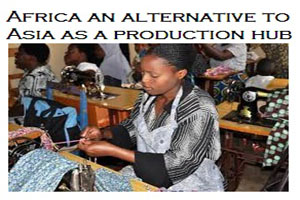
Africa an alternative to Asia as a production hub for global textile brands
YarnsandFibers News Bureau 2015-01-02 14:00:00 – AfricaGlobal textile retailers have found alternatives to Asia as a production hub as they saw some bad event happening in Asia’s textile industry in the year 2014 like the soaring labour wages in China, violent workers’ protests in Cambodia and collapsing factories in Bangladesh. These events points at the fact that the entire Asia textile industry seems to be in transition and the transition lies in a shift to a more value-adding industry.
For big global textile brands sourcing from these countries, such as Swedish chain H&M, Spain’s clothing giant Inditex or US-based WalMart, the slightly higher wages are only marginally affecting their business model because labour costs in the global textile retail industry make not more than 2% or 3% of the entire production costs including expenses for marketing, transport, sales, duties and taxes.
Higher wages are mostly just squeezing the profits of local textile production companies.
H&M, together with Tesco and Primark, have begun sourcing clothes from Ethiopia, an African country without industrial minimum wages where unskilled garment workers receive $35 to $40 a month, clearly undercutting labour costs in Bangladesh.
Foreign textile investors are highly welcomed and benefit from an abundance of cheap labour – with urban unemployment rates close to 20% –, cheap energy and locally produced cotton. In neighbouring Kenya, the textile industry is also expanding. Monthly salaries there are at around $120, but the government is trying to lure manufacturers with generous incentives.
Observers say that East African countries could have the potential to become a serious alternative to East Asia in terms of textile manufacturing. Apart from lower labour costs, it is quicker and cheaper to ship textile products from Africa to the main markets in Europe and the US, rather than from more distant countries in the Far East.
African countries also have duty-free access to the US textile market under a special trade agreement signed in 2000. And by utilizing and expanding native cotton production, producers could avoid expensive import by using local materials and aggregate the economic value of the industry in the respective countries.
China has already lost its appeal as cheap garment producing country – with current wages at around $500 a month in major industrial hubs along the country’s coast and $250 in the interior –, and foreign apparel retailers have turned to factories in Bangladesh and Cambodia in recent years.
Bangladesh’s textile sector has grown to a $25bn industry that employs 4.4mn people, and Cambodia`s grew to $5.5bn with more than 650,000 factory jobs.
But workers in these cheapest garment production countries are increasingly agitating for better pay. Bangladesh last year raised the minimum wage for the country’s garment workers by 77% to $68 a month following serious labour disputes.
In Cambodia, the labour ministry in November 2014 set the new monthly minimum wage for the country’s garment workers at $128, up from some $75 a month just a few years back and now almost double than in Bangladesh.
Market Intelligence
Ask for free sample Report

experience
Customer Base
dedicated team
Countries Served Worldwide









